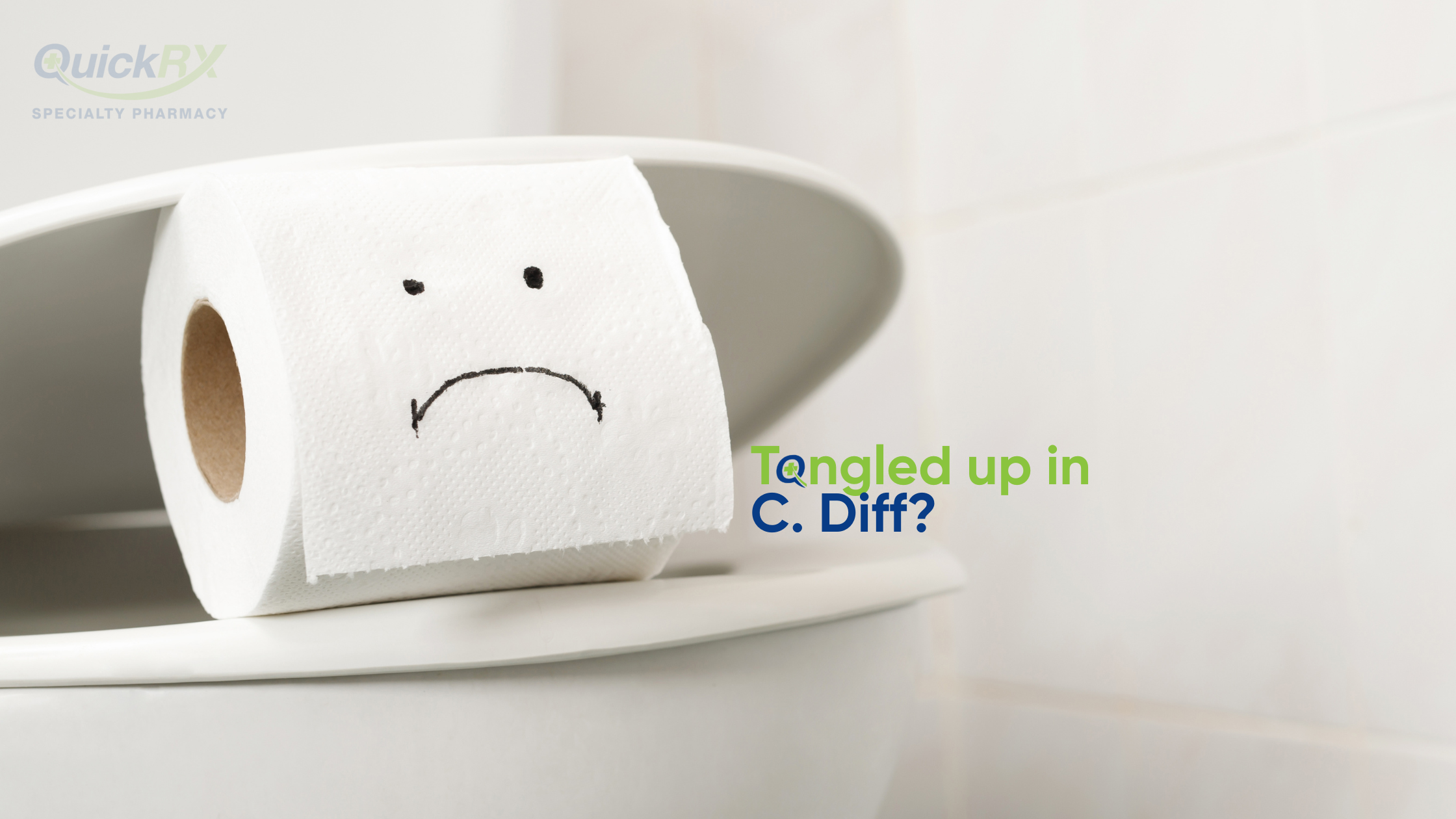You wash your hands religiously, sanitize everything, and think you’re safe from C. diff – but you’re wrong.
Meet C. diff (Clostridioides difficile), the sneaky bacteria that doesn’t care about your hand sanitizer obsession. C. diff infections are more common than you think, and when they strike, treatments like Dificid (fidaxomicin) can be expensive.
The Plot Twist Nobody Sees Coming
Here’s the thing that’ll really mess with your head: C. diff infections often happen to the most health-conscious people. You know, the ones who rush to the doctor at the first sign of trouble and dutifully take every antibiotic prescribed. The ones who think they’re being responsible.
How C. Diff Picks Its Targets
Clostridioides difficile is like that friend who only shows up when you’re already having a bad day. It typically strikes when your gut bacteria are down for the count, usually thanks to antibiotics that were supposed to make you feel better.
The Irony of Good Healthcare
The irony is almost poetic. The people most likely to get C. diff are often those who are most engaged with their healthcare, taking prescribed antibiotics exactly as directed, only to end up with a secondary infection that’s potentially worse than their original problem.
The “Clean” Problem

Finally, a cleaning method that actually works against C. diff spores
You might think C. diff is lurking in obviously dirty places, but this bacteria has expensive taste. It loves hospitals, nursing homes, and medical facilities. You know, those places that are supposedly sterile and safe.
Healthcare Settings: C. Diff Thrives in These Environments
Healthcare-associated infections are where C. diff really shines. These environments create the perfect storm: lots of antibiotic use, vulnerable patients, and despite rigorous cleaning protocols, C. diff spores can still survive.
Community-Acquired C. Diff: The New Reality
But here’s where it gets interesting: C. diff doesn’t just live in medical settings anymore. It’s branching out, going community-wide. That means your gym, your office, even your favorite restaurant could be hosting this uninvited guest.
Why Community Spread is Increasing
The rise in community-acquired C. diff infections is linked to several factors:
- Rising rates of antibiotic prescribing in outpatient settings
- Powerful antibiotic strains now circulating outside hospitals
- Improved diagnostic testing catching cases that were previously missed
Why Your Hand Sanitizer is Useless Here
Remember all that hand sanitizer you’ve been hoarding? Well, C. diff is basically immune to it. While you’ve been killing 99.9% of germs, C. diff has been sitting there in its protective spore form, completely unbothered by your alcohol-based defenses. Unfortunately, C. diff spores are like tiny, indestructible time capsules that can survive on surfaces for months.
The Spore Survival Strategy
- C. diff spores are like tiny, indestructible time capsules that can survive on surfaces for months. They laugh in the face of most cleaning products and can only be destroyed by bleach-based disinfectants.
What Actually Works Against C. Diff Spores
Effective Cleaning Methods
- Bleach-based disinfectants (1:10 dilution)
- Soap and water hand washing (mechanical removal)
- UV-C light disinfection systems
- Hydrogen peroxide vapor
Why Alcohol-Based Sanitizers Fail
Alcohol-based hand sanitizers work great against vegetative bacteria and many viruses, but C. diff spores have a tough outer coating that alcohol simply can’t penetrate. So much for that expensive hand sanitizer collection.
The Antibiotic Paradox

The ultimate plot twist: the treatment that was supposed to help sets you up for C. diff
This creates the perfect opportunity for C. diff to strike
The Gut Bacteria Massacre
Think of your gut bacteria as your body’s own personal security team. They keep the peace, maintain order, and make sure troublemakers like C. diff can’t move in and take over. But when you take antibiotics, it’s like firing your entire security staff.
Sure, the antibiotics might kill the bad bacteria causing your original infection, but they also wipe out the good guys. And in that moment of bacterial chaos, C. diff sees its opportunity and strikes.
The Usual Suspects: Antibiotics That Love to Cause Trouble
Some antibiotics are bigger troublemakers than others when it comes to C. diff:
The Big Three Culprits
Clindamycin: This one’s like giving C. diff a VIP invitation. It’s notorious for disrupting gut bacteria in all the wrong ways.
Fluoroquinolones: Medications like ciprofloxacin and levofloxacin are powerful but can clear the path for C. diff like a red carpet.
Broad-spectrum penicillins: These heavy hitters take out a lot of bacteria, both good and bad, leaving your gut vulnerable.
The Sneaky Enablers
Even antibiotics that seem “gentler” can potentially trigger C. diff in the right circumstances. It’s not just about which antibiotic you take, but also how long you take it and what your individual risk factors are.
The Demographics That’ll Surprise You

C. diff bingo: Turns out everyone can be affected by this infection
You might think C. diff only affects elderly people in nursing homes, but you’d be wrong. While age is definitely a risk factor, C. diff infections are increasingly affecting younger, healthier people.
The Age Factor
Yes, people over 65 are at higher risk, but recent studies show that C. diff infections in younger adults have been steadily increasing. Even children aren’t immune, though they’re less likely to develop symptoms.
The Health Status Surprise
You don’t need to be chronically ill to get C. diff. Healthy people who take antibiotics for routine infections like urinary tract infections or pneumonia can develop C. diff afterward. That’s right, treating your basic infection could lead to a much more serious problem.
The Gender and Lifestyle Factors
Interestingly, women are slightly more likely to develop C. diff infections, possibly because they receive antibiotics more frequently for urinary tract infections. And here’s something that might shock you: people who live cleaner lifestyles might actually be more susceptible because their gut bacteria diversity is lower.
When C. Diff Decides to Make Itself at Home
C. diff infections don’t just cause a little stomach upset and call it a day. When C. diff decides to colonize your gut, it can cause anything from mild diarrhea to life-threatening colitis.
The Toxin Troublemakers
How C. Diff Damages Your Gut
C. diff produces toxins (cleverly named Toxin A and Toxin B) that damage your intestinal lining. These toxins are what cause the inflammation, diarrhea, and abdominal pain that make C. diff infections so miserable.
The Inflammatory Response
When these toxins hit your intestinal walls, your body responds with massive inflammation. This inflammatory response is actually what causes many of the severe symptoms, not just the bacteria itself.
The Symptoms You Can’t Ignore
Classic C. Diff Symptoms
The hallmark signs include:
- Watery diarrhea (often 10-15 times per day)
- Severe abdominal cramping
- Fever
- Loss of appetite
- Nausea
When C. Diff Gets Serious
But here’s what’s scary: some people develop pseudomembranous colitis, where the colon becomes severely inflamed and can develop thick, yellowish plaques.
Life-Threatening Complications
In the worst cases, C. diff can cause:
- Toxic megacolon (dangerous colon enlargement)
- Colon perforation
- Sepsis
- Death (yes, C. diff can be fatal)
Treatment Options: When You Need the Big Guns

C. diff doesn’t discriminate – it can affect anyone, regardless of age or lifestyle
Effective C. diff treatment requires the right approach
C. Diff Treatment Options
Oral Vancomycin
For many years, oral vancomycin was the go-to treatment for C. diff infections. It’s effective but can be tough on your remaining gut bacteria.
Metronidazole (Flagyl)
Once commonly used for mild cases, metronidazole is now less frequently recommended due to lower cure rates and higher recurrence rates.
Advanced Treatment: Dificid (Fidaxomicin)
Why Dificid is Different
Dificid (fidaxomicin) represents a breakthrough in C. diff treatment, specifically targeting C. diff bacteria while preserving beneficial gut bacteria.
The Cost Reality
Dificid is incredibly effective but expensive. A 10-day course can cost thousands of dollars without insurance coverage.
Making Treatment Affordable
Fortunately, Dificid copay assistance programs can significantly reduce out-of-pocket costs for eligible patients. These programs help ensure that cost doesn’t prevent access to this life-saving medication.
Cutting-Edge Treatments
Fecal Microbiota Transplantation (FMT)
For recurrent C. diff infections, doctors sometimes recommend FMT, which involves transplanting healthy gut bacteria from a donor. Yes, it’s exactly what it sounds like.
Bezlotoxumab (Zinplava)
This monoclonal antibody helps prevent C. diff recurrence by neutralizing the bacteria’s toxins.
Don’t Let C. Diff Treatment Costs Overwhelm You
You C. diff infections are serious, but they’re treatable. The challenge many patients face isn’t finding effective medication like Dificid (fidaxomicin) – it’s affording it. That’s exactly why QuickRx exists.
QuickRx: Your Advocate for Affordable Dificid Treatment
At QuickRx, we understand that C. diff treatment shouldn’t be delayed because of cost concerns. That’s why our team of trusted advisors works tirelessly to advocate for lower copays for clients who need Dificid (fidaxomicin).
Our specialists navigate the complex world of Dificid copay assistance programs and patient support services to help reduce your out-of-pocket costs, sometimes down to $0 if you qualify. We handle the paperwork, coordinate with manufacturers, and fight for the best possible pricing so you can focus on what matters most: your recovery.
Don’t let medication costs stand between you and effective C. diff treatment. Contact QuickRx today and let our trusted advisors help you access the Dificid copay assistance you deserve.


